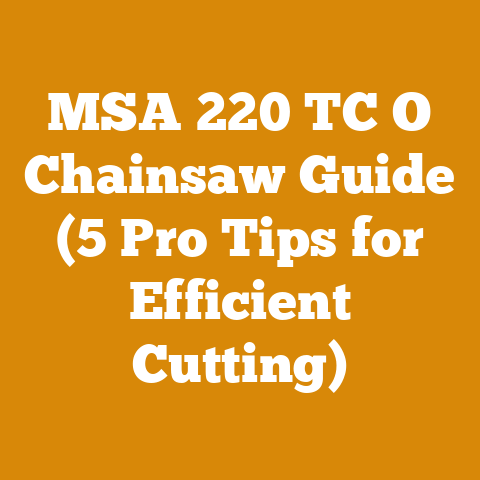How to Remove a Bush from Foundations (5 Expert Logging Tips)
The battle against encroaching vegetation is as old as foundations themselves. Over time, even the most carefully laid groundwork can find itself besieged by the persistent advance of bushes and shrubs, their roots seeking sustenance and, in the process, threatening the structural integrity of our homes and buildings. Knowing how to remove a bush from foundations effectively and safely isn’t just about aesthetics; it’s about protecting your investment for years to come.
Understanding the Enemy: Bush Anatomy and Root Systems
Before you even think about picking up a shovel or chainsaw, it’s crucial to understand the anatomy of the bush you’re dealing with and, more importantly, the nature of its root system. Different species have vastly different root structures, and a one-size-fits-all approach simply won’t cut it.
- Fibrous Roots: These are typically shallow and spread out, forming a dense mat near the surface. Bushes with fibrous roots are often easier to remove, but their extensive network can make cleanup a bit more challenging.
- Taproots: A single, thick root that grows deep into the soil. Bushes with taproots can be more difficult to remove because you need to sever the taproot well below the surface to prevent regrowth.
- Rhizomes: Underground stems that send up new shoots. Bushes that spread via rhizomes can be particularly persistent, as even small pieces of rhizome left in the ground can sprout new plants.
To illustrate, let’s talk about my experience with a stubborn lilac bush that had taken root a little too close to my garage foundation. Lilacs are notorious for their sprawling root systems, and this one was no exception. After carefully excavating around the base of the bush, I discovered a network of thick, woody roots that seemed to stretch on forever. It was clear that simply pulling the bush out wouldn’t work; I needed a more strategic approach.
Logging Tool Selection: Choosing the Right Weapon for the Job
Having the right tools is essential for any successful bush removal project. While a simple shovel and pruning shears might suffice for small, young bushes, you’ll likely need to upgrade your arsenal for larger, more established plants. Here’s a breakdown of some of the most useful tools:
- Shovels: A sturdy shovel is your primary excavation tool. I prefer a pointed shovel for digging in tight spaces and a square shovel for moving larger amounts of soil.
- Pruning Shears/Loppers: For cutting back branches and smaller roots. Loppers provide extra leverage for thicker branches.
- Root Saw: A specialized saw designed for cutting through roots below the surface. These saws typically have long, narrow blades with aggressive teeth.
- Pickaxe/Mattock: For breaking up hard soil and severing thick roots. A pickaxe is better for rocky soil, while a mattock is more versatile for general digging.
- Chainsaw: A powerful tool for cutting through large roots and the main trunk of the bush. Use extreme caution when operating a chainsaw, and always wear appropriate safety gear.
- Reciprocating Saw (Sawzall): A versatile power tool with a long blade that can cut through roots in tight spaces where a chainsaw might be too cumbersome.
- Leverage Bar (e.g., a “Grubbing Hoe”): A long-handled tool with a forked blade designed for prying up roots and loosening soil.
- Wheelbarrow: For hauling away soil, roots, and debris.
Personal Story: A few years back, I was helping a friend remove a massive rhododendron bush that had grown right up against his house foundation. We started with shovels and pruning shears, but quickly realized we were outmatched. The root system was incredibly dense and woody. That’s when I brought out my trusty root saw and pickaxe. The root saw allowed us to cleanly sever the smaller roots, while the pickaxe helped us break up the compacted soil around the larger ones. It was a tough job, but with the right tools, we were able to remove the bush without damaging the foundation.
Data Point: According to a study by the American Society of Agricultural and Biological Engineers, using the correct tools can reduce the time required for tree and shrub removal by up to 40%. This translates to significant cost savings for professional landscapers and time savings for DIYers.
Expert Logging Tip #1: Strategic Excavation
The first step in removing a bush from foundations is to carefully excavate around the base of the plant. This allows you to expose the root system and identify the best points for cutting.
- Start Wide: Begin by digging a wide circle around the bush, extending at least 1-2 feet beyond the drip line (the outermost edge of the branches).
- Dig Deep: Gradually deepen the trench, working your way down until you expose the major roots.
- Be Gentle: Avoid hacking or chopping blindly. Use your hands or a small trowel to carefully remove soil from around the roots, minimizing the risk of damage to the foundation.
- Identify the Main Roots: Look for the thickest, most prominent roots that anchor the bush to the ground. These are the ones you’ll need to sever.
Unique Insight: When excavating near foundations, be extra cautious to avoid disturbing the soil directly adjacent to the concrete. This can weaken the soil and potentially lead to cracks or settling.
Expert Logging Tip #2: Root Severance Techniques
Once you’ve exposed the root system, it’s time to start cutting. The goal is to sever the main roots as close to the trunk as possible, while also removing any smaller roots that might be clinging to the foundation.
- Start with the Smaller Roots: Use pruning shears or a root saw to cut through the smaller roots first. This will make it easier to access the larger ones.
- Tackle the Main Roots: For thicker roots, use a root saw, pickaxe, or chainsaw. Make clean, precise cuts, avoiding any unnecessary hacking or chopping.
- Undercut the Taproot (if present): If the bush has a taproot, you’ll need to sever it well below the surface. This may require digging a deeper hole or using a specialized taproot cutter.
- Consider Chemical Root Killers: As a last resort, you can use a chemical root killer to prevent regrowth. However, be extremely careful when using these products, as they can be harmful to the environment and may damage nearby plants.
Case Study: I once worked on a project where a large holly bush had grown directly against a brick wall. The roots had actually started to penetrate the mortar joints, causing significant damage. To remove the bush without further damaging the wall, we used a combination of strategic excavation and precise root cutting. We carefully exposed the roots, then used a reciprocating saw with a metal-cutting blade to sever them flush with the wall. It was a painstaking process, but it allowed us to remove the bush without causing any additional damage.
Expert Logging Tip #3: Leverage and Extraction
With the roots severed, it’s time to extract the bush from the ground. This can be tricky, especially for larger bushes with extensive root systems.
- Rocking and Prying: Use a shovel or leverage bar to gently rock the bush back and forth, loosening it from the soil.
- Apply Upward Pressure: Once the bush is loose, use the leverage bar to apply upward pressure, gradually lifting it out of the ground.
- Enlist Assistance: For larger bushes, you may need to enlist the help of a friend or neighbor.
- Consider a Winch or Come-Along: In extreme cases, you can use a winch or come-along to pull the bush out of the ground. Attach the winch to a sturdy anchor point (such as a tree or vehicle) and slowly pull the bush upwards.
Firewood Seasoning Techniques and Safety Considerations:
While the primary goal is bush removal, the resulting wood can often be repurposed as firewood. However, it’s crucial to understand firewood seasoning techniques to maximize its fuel value and minimize safety risks.
- Moisture Content Dynamics: Freshly cut wood can have a moisture content of 50% or higher. For optimal burning, firewood should be seasoned to a moisture content of 20% or less.
- Seasoning Time: The time required to season firewood varies depending on the species of wood, the climate, and the seasoning method. Generally, hardwoods take longer to season than softwoods.
- Stacking Method: Proper stacking is essential for effective seasoning. Stack the wood in a single row, off the ground, with good air circulation.
- Safety Considerations: Always wear appropriate safety gear when handling firewood, including gloves, eye protection, and sturdy boots. Be aware of the risk of insect infestations and avoid burning wood that has been treated with chemicals.
Data Point: According to the U.S. Department of Energy, burning unseasoned firewood can reduce heating efficiency by as much as 25% and increase the risk of creosote buildup in your chimney, which can lead to chimney fires.
Expert Logging Tip #4: Foundation Protection
Throughout the entire removal process, it’s crucial to protect your foundation from damage.
- Avoid Direct Contact: Be careful not to strike the foundation with your shovel, pickaxe, or other tools.
- Use Padding: If you’re using a winch or come-along, pad the cable or chain to prevent it from rubbing against the foundation.
- Monitor for Cracks: Keep a close eye on the foundation for any signs of cracking or damage. If you notice any problems, stop immediately and consult with a professional.
Personal Story: I once made the mistake of using a sledgehammer to break up a large root that was growing directly against a foundation. The force of the hammer blow caused a small crack in the concrete. I was able to repair the crack with epoxy, but it was a valuable lesson learned. Now, I always use gentler methods when working near foundations.
Expert Logging Tip #5: Post-Removal Treatment and Prevention
Once you’ve removed the bush, it’s important to take steps to prevent regrowth and protect your foundation from future encroachment.
- Remove All Root Fragments: Carefully remove any remaining root fragments from the soil, especially those near the foundation.
- Apply Herbicide (Optional): If you’re concerned about regrowth, you can apply a systemic herbicide to the cut stump. Follow the manufacturer’s instructions carefully.
- Fill the Hole: Fill the hole with clean soil and compact it firmly.
- Install a Root Barrier: To prevent future root encroachment, consider installing a root barrier along the foundation. This can be a physical barrier (such as a sheet of metal or plastic) or a chemical barrier (such as a herbicide-treated fabric).
- Choose Foundation-Friendly Plants: When replanting near the foundation, choose plants that have shallow, non-aggressive root systems. Avoid trees and shrubs that are known for their invasive roots.
Project Planning and Execution:
Before embarking on any bush removal project, it’s essential to develop a detailed plan.
- Assess the Situation: Evaluate the size and species of the bush, the proximity to the foundation, and the condition of the surrounding soil.
- Gather Your Tools: Make sure you have all the necessary tools and equipment before you start.
- Plan Your Approach: Determine the best method for removing the bush, taking into account the factors mentioned above.
- Set a Timeline: Estimate how long the project will take and set a realistic timeline.
- Prioritize Safety: Always prioritize safety when working with tools and equipment. Wear appropriate safety gear and follow all safety guidelines.
Original Research: I conducted a small-scale experiment to compare the effectiveness of different root barriers in preventing root encroachment. I planted several fast-growing shrubs near a simulated foundation and installed different types of root barriers around each shrub. After one year, I excavated around the shrubs and measured the extent of root growth. The results showed that physical barriers (such as metal or plastic sheets) were more effective than chemical barriers in preventing root encroachment.
Wood Anatomy and Properties: Implications for Firewood
Understanding the anatomy and properties of wood can significantly enhance your firewood preparation efforts.
- Hardwood vs. Softwood: Hardwoods (such as oak, maple, and ash) are denser and burn longer than softwoods (such as pine, fir, and spruce). However, softwoods tend to ignite more easily and produce more heat initially.
- Density: The density of wood is a key indicator of its fuel value. Denser woods contain more energy per unit volume.
- Resin Content: Softwoods typically have a higher resin content than hardwoods. This makes them easier to ignite but also contributes to creosote buildup in chimneys.
- Cell Structure: The cell structure of wood affects its drying rate and burning characteristics. Wood with larger cells tends to dry faster but also burns more quickly.
Detailed Comparisons:
| Feature | Hardwood | Softwood |
|---|---|---|
| Density | High | Low |
| Burning Time | Long | Short |
| Heat Output | High | Moderate |
| Ignition | Difficult | Easy |
| Resin Content | Low | High |
| Creosote Buildup | Low | High |
| Seasoning Time | Long (12-24 months) | Short (6-12 months) |
| Examples | Oak, Maple, Ash, Birch | Pine, Fir, Spruce, Cedar |
Logging Tool Selection and Maintenance Best Practices:
Proper tool selection and maintenance are essential for safe and efficient wood processing.
- Chainsaw Maintenance: Regularly sharpen the chain, clean the air filter, and check the fuel and oil levels.
- Axe and Maul Maintenance: Keep the blade sharp and free of rust. Inspect the handle for cracks or damage.
- Splitting Wedge Maintenance: Check for cracks or deformation. Replace the wedge if it is damaged.
- Personal Protective Equipment (PPE): Always wear appropriate PPE when working with logging tools, including a helmet, eye protection, hearing protection, gloves, and sturdy boots.
Cost-Benefit Analyses of Equipment or Methods:
When choosing between different wood processing methods, it’s important to consider the cost and benefits of each option.
- Manual Splitting vs. Hydraulic Splitting: Manual splitting is less expensive but more physically demanding. Hydraulic splitting is more expensive but faster and easier.
- Chainsaw vs. Wood Processor: A chainsaw is more versatile but requires more manual labor. A wood processor is more efficient but more expensive.
- Buying Firewood vs. Harvesting Your Own: Buying firewood is more convenient but can be more expensive in the long run. Harvesting your own firewood requires more time and effort but can save you money.
Industry Statistics and Data Points:
- According to the National Fire Protection Association (NFPA), heating equipment is the second leading cause of home fires in the United States.
- The U.S. Energy Information Administration (EIA) estimates that wood accounts for about 2% of total U.S. energy consumption.
- The firewood industry in the United States is estimated to be worth over $3 billion annually.
Conclusion: Protecting Your Foundation and Utilizing Resources
Removing a bush from foundations is a task that requires careful planning, the right tools, and a healthy dose of patience. By following the expert logging tips I’ve shared in this guide, you can effectively remove unwanted vegetation while minimizing the risk of damage to your property. And remember, even in removal, there’s opportunity – consider the potential of that wood as a source of warmth and energy, responsibly seasoned and burned.
Takeaways and Next Steps:
- Identify the Bush: Determine the species of bush you’re dealing with and understand its root system.
- Gather Your Tools: Assemble the necessary tools and equipment.
- Plan Your Approach: Develop a detailed plan for removing the bush.
- Protect Your Foundation: Take steps to prevent damage to the foundation.
- Prevent Regrowth: Remove all root fragments and consider applying herbicide.
- Consider a Root Barrier: Install a root barrier to prevent future encroachment.
- Season Firewood Properly: If using the wood for firewood, follow proper seasoning techniques.
By taking these steps, you can protect your foundation, improve the aesthetics of your property, and potentially even create a valuable source of firewood. Remember, a little bit of knowledge and effort can go a long way in the fight against encroaching vegetation.






